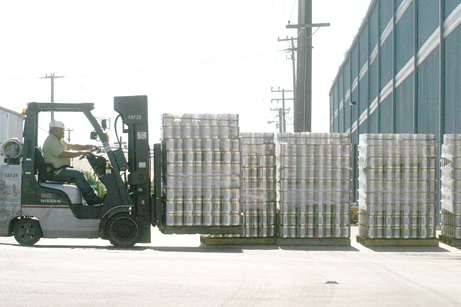
Tomato harvest affected by heat in July, farmers take a hit on
this year’s crop
The streets running through San Benito Foods processing plant in
Hollister are typically humming with activity in September.
Forklifts scurry No. 10 cans of tomatoes between warehouses while
trucks constantly roll in bearing tons of freshly picked
tomatoes.
Not this year.
Tomato harvest affected by heat in July, farmers take a hit on this year’s crop
The streets running through San Benito Foods processing plant in Hollister are typically humming with activity in September. Forklifts scurry No. 10 cans of tomatoes between warehouses while trucks constantly roll in bearing tons of freshly picked tomatoes.
Not this year.
Sally and East streets are nearly deserted, save for an occasional forklift carrying nothing but empty pallets and a driver who is closing bay doors. In years past, the sounds of the boilers competed with conversations on the streets. The smell of processed tomatoes frequently blanketed the town during September.
By some estimates the cannery shut down a month early this year, fueling the ever-present rumors that the operation will soon be shutting down permanently – the victim of economics that favor processing closer to where the product is grown: the Central Valley.
“I’ve heard that this is its last year, that it is moving to someplace like Firebaugh,” said one business owner adjacent to the cannery where cannery workers often frequent.
But another business owner across the street says rumors of an early demise of the cannery have been circulating for at least 10 years.
Cannery officials remain mum, while representatives from Teamsters Local 890 couldn’t be located to comment this week.
But others, including one cannery worker talking to a forklift operator on Sally Street, say the mid-September shutdown was no more ominous than a problematic crop.
“Guess the tomatoes weren’t that good,” she said.
She was right.
Ross Siragusa, president and CEO of the California Tomato Growers Association in Stockton, confirmed that the harvest is coming in roughly 12 percent lower than the estimates established in January.
“What the processors wanted [statewide] was 11.4 million tons,” Siragusa said. “We’ll be lucky if we hit 10 million – it will likely be more like 9.5 million.”
The quality of the fruit is not as good because the heat wave in July caused some sunburning, Siragusa said. When tomato vines are exposed to that much heat, the fruit development tends to shut down, and these “delayed” fields will have much lower yields, he said.
The cannery operation in Hollister is more susceptible to ups and downs of harvests because of the additional costs of hauling the fruit over from the Central Valley, particularly with fuel costs running so high, Siragusa said.
While the Hollister plant shut down mid-September, the Central Valley processors are still humming. Part of the reason is that fewer canning tomatoes are being grown in San Benito County, Siragusa said, noting that there are only two growers of canning tomatoes still in operation.
Tomato production in San Benito County has declined – down from 54,630 tons in 2004 to 50,200 tons last year. While the unit price edged up slightly from $49 a ton to $52 a ton last year, total production brought in slightly less for local growers: $2.61 million last year compared to $2.68 million in 2004.
Paul Matulich, the San Benito County Agricultural Commissioner, said tomato crops in San Benito County have been decreasing dramatically during the past four decades.
“When I first came to work here in March of 1965, we had 3,000 to 4,000 acres,” he said. “Now we might have 600.”
Tomatoes are a difficult crop to make money on. While costs continue to climb, the price per ton has stagnated. Matulich can’t remember a time when the per-ton price has ever been more than $60.
Growers in the Central Valley are able to make up some of the costs by the shear volume they plant, Matulich said. In the Central Valley growers plant in blocks that are 300 to 400 acres square. Here, 50-acre blocks are considered large.
While businesses and residents around the cannery all say they are perplexed about the why operations shut down early this year, all, including two men nursing beers across the street from the cannery, said most years the processing runs well into October.
Central Valley growers point to the scorching weather that hit California during July for the off year.
“The problems can be seen just by looking at the trucks hauling the harvest to processing plants. Typically, a fully loaded tomato truck holds 25 tons of fruit. But this season, a truck holding the same number of tomatoes carries as little as 18 tons of weight,” reported the Central Valley Business Times last week.
“Prices will continue to climb for the entire category including round tomatoes, Romas, grape and cherry tomatoes. Growers have warned of the possibility of not being able to fill orders in full or having to substitute sizes or varieties. The supply situation may become critical in the near future,” wholesaler General Produce Co. of Sacramento told the Times.
The California Tomato Growers Association reported prices per ton this year range from $57 to $58, and that growers will likely lose money on their crops. The association also reported in a bulletin that the 2006 harvest will be sharply behind the previous seven years.
“The price of tomatoes continues to climb,” Siragusa said. “We’re expecting prices to hit $65 [per ton] next year. Hopefully that will put us in position for growers to make some money.”
Pinnacle reporter Patrick O’Donnell contributed to this report.









